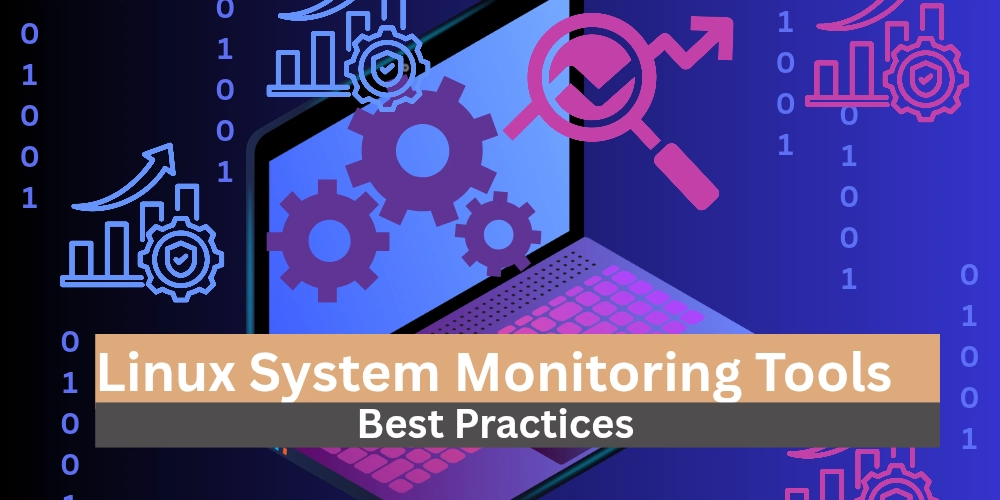System Performance Monitoring
Table of Contents Why Monitoring Matters What to Monitor (Key Performance Metrics) 1. CPU Usage 2. Memory Usage 3. Disk I/O and Storage 4. Network Usage 5. Processes and Services 6. System Logs Tools to Automate Monitoring Best Practices Conclusion Let's Connect on LinkedIn Why Monitoring Matters You’ve updated your systems. Applied patches. Everything seems fine. But no system can be truly secure or efficient without ongoing monitoring. Lack of Monitoring Leads to Vulnerability: No logs = No alerts = delayed response to attacks or resource exhaustion No visibility means attackers could go unnoticed (e.g., unauthorized SSH access) Unpatched systems or performance spikes might indicate compromise but without monitoring, you'd never know. Cybercriminals thrive in the dark. Monitoring shines a light. In a production environment, a slow server is more dangerous than a down server. Because it appears to be working until users start complaining. That’s where system performance monitoring comes in. Linux monitoring acts as your early warning system, ensuring the system is: Available (users and applications can access it) Responsive (no slowdowns or timeouts) Efficient (resources are used properly) Stable (no unexpected crashes or overloads) What to Monitor (Key Performance Metrics) 1. CPU Usage Tracks how much processor time is being used. High usage may indicate heavy processes or a bottleneck. Tools: top, htop, mpstat, sar 2. Memory Usage Includes RAM and swap usage. Consistently high memory could lead to thrashing. Tools: free -m, vmstat, top, smem 3. Disk I/O and Storage Monitors how fast and frequently the disk is being read/written to. Disk bottlenecks can affect database performance, logging, backups, etc. Tools: iostat, iotop, df -h, du, lsblk 4. Network Usage Measures traffic in/out, bandwidth usage, and errors. Helps detect congestion, packet loss, or DDoS attacks. Tools: iftop, nethogs, netstat, ss, ping, traceroute 5. Processes and Services Ensures critical services are running and performing as expected. Tracks resource-hungry or zombie processes. Tools: ps aux, systemctl status, top, journalctl 6. System Logs Check logs for warnings, errors, failed authentications. Location: /var/log/, /var/log/messages, /var/log/syslog, /var/log/auth.log Tools: tail -f, grep, journalctl Tools to Automate Monitoring Glances : real-time overview Zabbix : graphs, alerts, dashboard Netdata : intuitive web UI Nagios : powerful alert system Prometheus + Grafana : modern dashboards and metrics While tools are essential, monitoring is not just about tools. It’s about: Setting performance thresholds Understanding baselines Creating alert systems Interpreting logs and metrics to make informed decisions Best Practices Set alerts for CPU, memory, disk, and network Establish baseline performance Monitor trends to scale resources ahead Combine command-line tools with automated platforms Conclusion Monitoring = Tools + Skills + Logs + Baselines + Action Plan System monitoring is a preventive shield, a performance enhancer, and your early warning system. You don’t need to wait until there's a problem. Start watching now before someone else is watching for you. Let’s connect on LinkedIn (https://www.linkedin.com/in/chiamaka-chielo?utm_source=share&utm_campaign=share_via&utm_content=profile&utm_medium=android_app) As I automate my journey into RHCE and Ansible, I’d love to connect with fellow learners and professionals. Feel free to reach out and join me as I share tips, resources, and insights throughout this 30-day challenge. cloudwhistler #30daysLinuxchallenge

Table of Contents
- Why Monitoring Matters
-
What to Monitor (Key Performance Metrics)
- 1. CPU Usage
- 2. Memory Usage
- 3. Disk I/O and Storage
- 4. Network Usage
- 5. Processes and Services
- 6. System Logs
- Tools to Automate Monitoring
- Best Practices
- Conclusion
- Let's Connect on LinkedIn
Why Monitoring Matters
You’ve updated your systems. Applied patches. Everything seems fine.
But no system can be truly secure or efficient without ongoing monitoring.
Lack of Monitoring Leads to Vulnerability:
- No logs = No alerts = delayed response to attacks or resource exhaustion
- No visibility means attackers could go unnoticed (e.g., unauthorized SSH access)
- Unpatched systems or performance spikes might indicate compromise but without monitoring, you'd never know.
Cybercriminals thrive in the dark. Monitoring shines a light.
In a production environment, a slow server is more dangerous than a down server.
Because it appears to be working until users start complaining.
That’s where system performance monitoring comes in.
Linux monitoring acts as your early warning system, ensuring the system is:
- Available (users and applications can access it)
- Responsive (no slowdowns or timeouts)
- Efficient (resources are used properly)
- Stable (no unexpected crashes or overloads)
What to Monitor (Key Performance Metrics)
1. CPU Usage
Tracks how much processor time is being used.
High usage may indicate heavy processes or a bottleneck.
Tools: top, htop, mpstat, sar
2. Memory Usage
Includes RAM and swap usage.
Consistently high memory could lead to thrashing.
Tools: free -m, vmstat, top, smem
3. Disk I/O and Storage
Monitors how fast and frequently the disk is being read/written to.
Disk bottlenecks can affect database performance, logging, backups, etc.
Tools: iostat, iotop, df -h, du, lsblk
4. Network Usage
Measures traffic in/out, bandwidth usage, and errors.
Helps detect congestion, packet loss, or DDoS attacks.
Tools: iftop, nethogs, netstat, ss, ping, traceroute
5. Processes and Services
Ensures critical services are running and performing as expected.
Tracks resource-hungry or zombie processes.
Tools: ps aux, systemctl status, top, journalctl
6. System Logs
Check logs for warnings, errors, failed authentications.
Location:
/var/log/, /var/log/messages, /var/log/syslog, /var/log/auth.log
Tools: tail -f, grep, journalctl
Tools to Automate Monitoring
- Glances : real-time overview
- Zabbix : graphs, alerts, dashboard
- Netdata : intuitive web UI
- Nagios : powerful alert system
- Prometheus + Grafana : modern dashboards and metrics
While tools are essential, monitoring is not just about tools.
It’s about:
- Setting performance thresholds
- Understanding baselines
- Creating alert systems
- Interpreting logs and metrics to make informed decisions
Best Practices
- Set alerts for CPU, memory, disk, and network
- Establish baseline performance
- Monitor trends to scale resources ahead
- Combine command-line tools with automated platforms
Conclusion
Monitoring = Tools + Skills + Logs + Baselines + Action Plan
System monitoring is a preventive shield, a performance enhancer, and your early warning system.
You don’t need to wait until there's a problem.
Start watching now before someone else is watching for you.
Let’s connect on LinkedIn
As I automate my journey into RHCE and Ansible, I’d love to connect with fellow learners and professionals. Feel free to reach out and join me as I share tips, resources, and insights throughout this 30-day challenge.





































































































































































![[The AI Show Episode 145]: OpenAI Releases o3 and o4-mini, AI Is Causing “Quiet Layoffs,” Executive Order on Youth AI Education & GPT-4o’s Controversial Update](https://www.marketingaiinstitute.com/hubfs/ep%20145%20cover.png)











































































































![Re-designing a Git/development workflow with best practices [closed]](https://i.postimg.cc/tRvBYcrt/branching-example.jpg)















![[DEALS] Microsoft 365: 1-Year Subscription (Family/Up to 6 Users) (23% off) & Other Deals Up To 98% Off – Offers End Soon!](https://www.javacodegeeks.com/wp-content/uploads/2012/12/jcg-logo.jpg)




![From Art School Drop-out to Microsoft Engineer with Shashi Lo [Podcast #170]](https://cdn.hashnode.com/res/hashnode/image/upload/v1746203291209/439bf16b-c820-4fe8-b69e-94d80533b2df.png?#)










































































































(1).jpg?#)


















![What Google Messages features are rolling out [May 2025]](https://i0.wp.com/9to5google.com/wp-content/uploads/sites/4/2023/12/google-messages-name-cover.png?resize=1200%2C628&quality=82&strip=all&ssl=1)











_Inge_Johnsson-Alamy.jpg?width=1280&auto=webp&quality=80&disable=upscale#)
















































































































![New Apple iPad mini 7 On Sale for $399! [Lowest Price Ever]](https://www.iclarified.com/images/news/96096/96096/96096-640.jpg)
![Apple to Split iPhone Launches Across Fall and Spring in Major Shakeup [Report]](https://www.iclarified.com/images/news/97211/97211/97211-640.jpg)
![Apple to Move Camera to Top Left, Hide Face ID Under Display in iPhone 18 Pro Redesign [Report]](https://www.iclarified.com/images/news/97212/97212/97212-640.jpg)
![Apple Developing Battery Case for iPhone 17 Air Amid Battery Life Concerns [Report]](https://www.iclarified.com/images/news/97208/97208/97208-640.jpg)



































































































